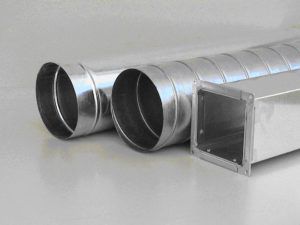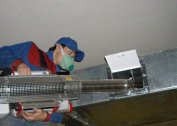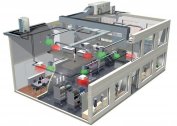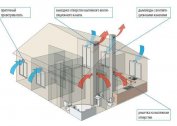When calculating and installing ventilation, much attention is paid to the amount of fresh air entering through these channels. For the calculations, standard formulas are used that well reflect the relationship between the dimensions of the exhaust devices, the speed of movement and the air flow. Some standards are spelled out in SNiPs, but for the most part they are advisory in nature.
General principles of calculation
Air ducts can be made of various materials (plastic, metal) and have different shapes (round, rectangular). SNiP regulates only the dimensions of the exhaust devices, but does not standardize the amount of drawn-in air, since its consumption, depending on the type and purpose of the room, can vary greatly. This parameter is calculated using special formulas that are selected separately. The norms are set only for social facilities: hospitals, schools, preschool institutions. They are prescribed in SNiPs for such buildings. However, there are no clear rules on the speed of air in the duct. There are only recommended values and norms for forced and natural ventilation, depending on its type and purpose, they can be found in the corresponding SNiPs. This is reflected in the table below. Air velocity is measured in m / s.
The data in the table can be supplemented as follows: during natural ventilation, the air velocity cannot exceed 2 m / s, regardless of its purpose, the minimum allowable is 0.2 m / s. Otherwise, updating the gas mixture in the room will be insufficient. For forced exhaust, the maximum allowable value is 8 -11 m / s for main ducts. These standards should not be exceeded, because this will create too much pressure and resistance in the system.
Formulas for calculating
To carry out all the necessary calculations, you must have some data. To calculate the air speed, you need the following formula:
ϑ = L / 3600 * Fwhere
ϑ - air flow rate in the pipeline of the ventilation device, measured in m / s;
L - air mass flow (this value is measured in m3/ h) on the section of the exhaust shaft for which the calculation is being made;
F - the cross-sectional area of the pipeline, measured in m2.
According to this formula, the air velocity in the duct is calculated, and its actual value.
From the same formula, all other missing data can be derived. For example, in order to calculate airflow, the formula needs to be converted as follows:
L = 3600 x F x ϑ.
In some cases, such calculations are difficult or time-consuming. In this case, you can use a special calculator. There are many similar programs on the Internet. It is better for engineering bureaus to install special calculators that are more accurate (they subtract the thickness of the pipe wall when calculating its cross-sectional area, put more signs in pi, calculate more accurate air flow, etc.).
It is necessary to know the air velocity in order to calculate not only the volume of the gas mixture, but also to determine the dynamic pressure on the channel walls, friction and drag losses, etc.
Some helpful hints and tips
 As can be understood from the formula (or when carrying out practical calculations on calculators), the air velocity increases with a decrease in the size of the pipe. A number of advantages can be derived from this fact:
As can be understood from the formula (or when carrying out practical calculations on calculators), the air velocity increases with a decrease in the size of the pipe. A number of advantages can be derived from this fact:
- there will be no losses or the need to lay an additional ventilation pipe to ensure the necessary air flow, if the dimensions of the room do not allow for large channels;
- smaller pipelines can be laid, which in most cases is simpler and more convenient;
- the smaller the diameter of the channel, the cheaper its cost; the price of additional elements (dampers, valves) will also decrease;
- the smaller size of the pipes expands the installation options, they can be arranged as needed, practically without adapting to external constraining factors.
However, when laying smaller ducts, it must be remembered that with increasing air velocity, the dynamic pressure on the pipe walls increases, the system resistance also increases, accordingly a more powerful fan and additional costs will be required. Therefore, before installation, it is necessary to carefully carry out all calculations so that the savings do not result in large costs or even losses, because a building that does not comply with SNiP standards may not be allowed to operate.




